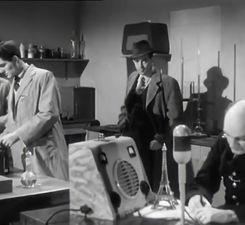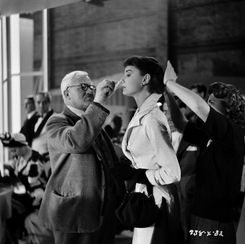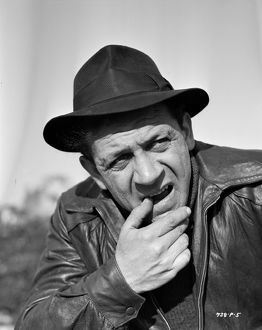
.com

Estd. 2020
Approved by the Shaw Family
Centenary Project
2027








"The word "Macho" could have been invented for him." - Guy Hamilton

trailer
Robert Shaw as Police Laboratory Technician (non-speaking)

A meek bank clerk who oversees the shipment of bullion joins with an eccentric neighbour to steal gold bars and smuggle them out of the country as miniature Eiffel Towers.
Directed by Charles Crichton
Screenplay by T.E.B. Clarke
Produced by Michael Balcon and Michael Truman
Music by Georges Auric
Cinematography by Douglas Slocombe
Edited by Seth Holt
Also starring Alec Guinness, Stanley Holloway, Sidney James, Audrey Hepburn, Alfie Bass and Majorie Fielding
Released by The Rank Organisation
Release Date: June 28th 1951
Running Time: 81 minutes
Location(s): Ealing Studios, London

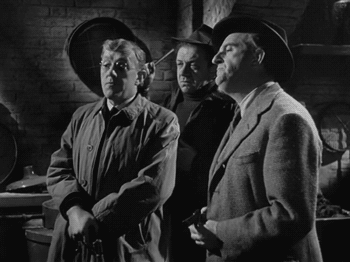
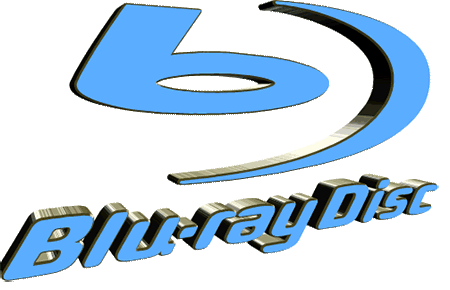







gallery


The Cellar
SHORTY AND LACKERY JOIN UP
Sidney James and Alfie Bass are recruited into the gang.
OFFICIAL SOUNDTRACK
Title track composed by Georges Auric play by the BBC Orchestra.
THE CAR CHASE
Alec Guinness and Stanley Holloway steal a police car.
HELLO AUDREY!
The legendary Audrey Hepburn in an early film role in this cameo appearance.







PRESS PLAY




DIRECTOR
Charles Crichton
(1910 - 1999)




Alec
Guinness
(1914 - 2000)
Stanley
Holloway
(1890 - 1982)
Sidney
James
(1913 - 1976)

Audrey
Hepburn
(1929 - 1993)

Alfie
Bass
(1916 - 1987)

Majorie
Fielding
(1892 - 1956)


A comedy classic from Ealing Studios and Robert's first foray into film in this non-speaking part.
He was given the opportunity by Alec Guinness who was very impressed with Shaw when he saw him on stage. It's a breezy caper with a strong ensemble cast and a wonderful soundtrack.
We also get early glimpses of Audrey Hepburn and the comedy legend Sid James in an early role.
It's a blink and you'll miss him, but everyone has to start somewhere.

Lobby Card Gallery


By Rhianna Evans of
The British Comedy Guide
It is undoubtedly one of the most universally loved films in cinema history. Ranked by the BFI as the 17th greatest British film ever made, the screenplay picked up an Oscar, and - perhaps most surprisingly of all - it is one of only fifteen films to be officially listed as 'art' by the Vatican. It is British comedy's equivalent of Citizen Kane.
So, who created this complete and utter masterpiece? The film was penned by one man, T.E.B. Clarke (Thomas Ernest Bennett "Tibby" Clarke) who had already become Ealing's most sought-after scriptwriter following the successes of his earlier comedies and dramas.
Primarily, he was a screenwriter, but he was also a novelist, a journalist and former policeman whose unique approach to scripting comedy managed to capture an extra special element. It could be said that before Ealing's golden period the top priority of the studio had always been to make a comedy funny, but not necessarily cinematic. Clarke was part of the team that changed all that. They came along and turned British screen comedy on its head, redefining the genre for generations to come.
The Lavender Hill Mob is the simple story of a heist. Our protagonist is one Henry Holland (Alec Guinness) an unassuming bank clerk charged with overseeing gold bullion deliveries. After being on the straight and narrow for over twenty years something changes within him, and in his mind he formulates a plan: a daring gold robbery.
His scheme becomes plausible when he meets Alfred Pendlebury (Stanley Holloway), who joins him as a lodger of the Balmoral Hotel of Lavender Hill (a real Victorian street located in South Battersea, London). Pendlebury just happens to be a souvenir manufacturer, specialising in the production of large paperweight models of the Eiffel Tower - he's just the man to assist in what will surely be the most audacious robbery ever to be carried out on British soil... if they can pull it off.
To Clarke, plot and artistry mattered. Of all his films, The Lavender Hill Mob in particular features some gorgeous cinematography (courtesy of director Charles Crichton and cinematographer Douglas Slocombe). There's something incredibly poetic about our protagonist gently leafing molten gold off his shoe with the tip of his umbrella (later molten metal, as he watches Pendlebury cast the Eiffel Towers, thus giving him an idea...). Most fans will have this moment burned into their memory, such is its strength as a piece of visual storytelling.
Alec Guinness plays Henry to perfection; his character is fastidious, with quite a cold and calculating streak, but there's no doubt that you root for the duo when they inevitably team up. The scene in which Henry tests the water with Alfred is a real example of the drama Clarke was determined to draw into his comedies. There's an uneasy tension as Holland declares: 'Supposing one had the right sort of partner, in the form of... erm, shall we say... Eiffel Tower paperweights...?'. The acting and atmosphere of this scene is worthy of any genuine, straight-faced heist movie, and as the audience becomes more immersed in the stakes, the dry, deadpan humour becomes ever funnier.
Clarke was well-known for his meticulous research into the premise of his plots. For The Lavender Hill Mob he presented himself before a teller at the Bank of England with a note: 'Information required on means of stealing gold bullion'. Within minutes he had almost the entire bank helping him work through plot ideas; they even set up a special committee to come up with various scenarios that would be both plausible and entertaining enough for a comedic heist.
There is a magic woven through the very fabric of this film. The casting is so on point: the careers of many future stars launch right here. International screen icon Audrey Hepburn makes one of her earliest film appearances: a cameo at Alec Guinness's insistence, though she doesn't share a scene with Stanley Holloway - her on-screen father in the classic 1964 musical My Fair Lady. Jaws legend Robert Shaw makes his first celluloid appearance in a non-speaking role as a police chemist.
But chiefly, The Lavender Hill Mob proved to showcase two very important characters in the history of British comedy. For Holland and Pendlebury are not alone in their endeavour, by chance they happen upon two other crooks: one is Shorty Fisher, played by Alfie Bass (who would go on to have a long-lasting comedy career across stage, radio and screen) and the other is Lackery Wood - played by a certain Sidney James.
Sid makes an entrance worthy of his legendary status. Resident in Britain for just over 3 years and hitherto specialising in Cockney criminal roles across thrillers and dramas, this is his debut screen comedy: not an enormous role, despite achieving third billing, but he makes his mark. 'Who are you?' demand Holland and Pendlebury, with guns loaded and pointing at him. 'Oh, take those things away, I'm not hungry!'
Sid dismisses with his typical carefree charm and presence. He's a crook with a twinkle in his eye, the lovable rogue. Here, in this scene, you are looking at the origins, not just of Sid James's on-screen persona, but of many towering heroes of Britcom: Private Walker, Norman Stanley Fletcher and Del Boy to name but a few.
Of course, most Ealing films had a moralising element and as such the realities of Holland and Pendlebury's crime runs seamlessly into large-scale farce. From a great chemistry between the two lead actors, there come some beautifully whimsical moments but one in particular must have been a technical nightmare to shoot, especially when you consider the year this film was produced (1950) coupled with Ealing Studios' limited budget.
Most of the film was shot in London, still visibly deeply scarred from the war. Several bombed-out locations can be glimpsed throughout the film, baring the capital's still-oozing sores from the Blitz. Some six years after hostilities had ended, buildings and lives were still teetering on the brink: but there's a sense of a phoenix beginning to rise from the ashes.
Post-war, a new dawn in British comedy was awakening, and after Holland and Pendlebury came hurtling down the Eiffel Tower, suitcases firmly in hand, with their coats flying, and hats floating aimlessly on the breeze, things would never be the same again.



